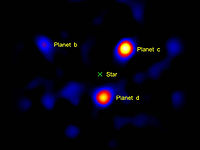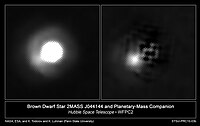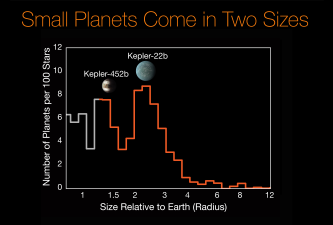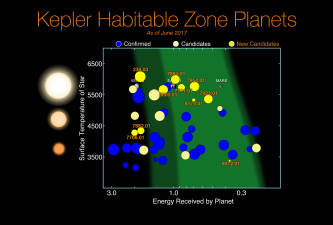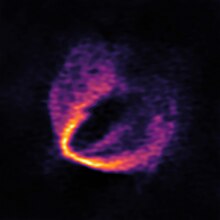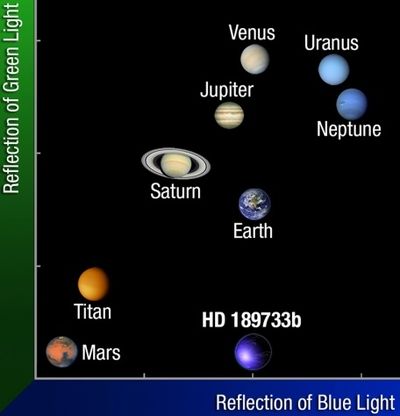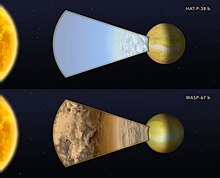
Size comparison of Jupiter and the exoplanet TrES-3b. TrES-3b has an orbital period of only 31 hours and is classified as a Hot Jupiter for being large and close to its star, making it one of the easiest planets to detect by the transit method.
There are many methods of detecting exoplanets. The High Accuracy Radial Velocity Planet Searcher (HARPS) has discovered about a hundred exoplanets since 2004, while the Kepler space telescope has since 2009 has found more than two thousand. Kepler has also detected a few thousand candidate planets, of which up to 40% may be false positives. In several cases, multiple planets have been observed around a star. About 1 in 5 Sun-like stars have an "Earth-sized" planet in the habitable zone. Assuming there are 200 billion stars in the Milky Way, one can hypothesize that there are 11 billion potentially habitable Earth-sized planets in the Milky Way, rising to 40 billion if planets orbiting the numerous red dwarfs are included.
The least massive planet known is Draugr (also known as PSR B1257+12 A or PSR B1257+12 b), which is about twice the mass of the Moon. The most massive planet listed on the NASA Exoplanet Archive is HR 2562 b, about 30 times the mass of Jupiter, although according to some definitions of a planet, it is too massive to be a planet and may be a brown dwarf instead. There are planets that are so near to their star that they take only a few hours to orbit and there are others so far away that they take thousands of years to orbit. Some are so far out that it is difficult to tell whether they are gravitationally bound to the star. Almost all of the planets detected so far are within the Milky Way. Nonetheless, evidence suggests that extragalactic planets, exoplanets further away in galaxies beyond the local Milky Way galaxy, may exist. The nearest exoplanet is Proxima Centauri b, located 4.2 light-years (1.3 parsecs) from Earth and orbiting Proxima Centauri, the closest star to the Sun.
The discovery of exoplanets has intensified interest in the search for extraterrestrial life. There is special interest in planets that orbit in a star's habitable zone, where it is possible for liquid water, a prerequisite for life on Earth, to exist on the surface. The study of planetary habitability also considers a wide range of other factors in determining the suitability of a planet for hosting life.
Besides exoplanets, there are also rogue planets, which do not orbit any star. These tend to be considered separately, especially if they are gas giants, in which case they are often counted as sub-brown dwarfs, like WISE 0855−0714. The rogue planets in the Milky Way possibly number in the billions (or more).
Nomenclature
Exoplanet HIP 65426b is the first discovered planet around star HIP 65426.
The convention for designating exoplanets is an extension of the
system used for designating multiple-star systems as adopted by the International Astronomical Union
(IAU). For exoplanets orbiting a single star, the designation is
normally formed by taking the name or, more commonly, designation of its
parent star and adding a lower case letter.
The first planet discovered in a system is given the designation "b"
(the parent star is considered to be "a") and later planets are given
subsequent letters. If several planets in the same system are discovered
at the same time, the closest one to the star gets the next letter,
followed by the other planets in order of orbital size. A provisional
IAU-sanctioned standard exists to accommodate the designation of circumbinary planets. A limited number of exoplanets have IAU-sanctioned proper names. Other naming systems exist.
History of detection
For centuries scientists, philosophers, and science fiction writers suspected that extrasolar planets existed, but there was no way of detecting them or of knowing their frequency or how similar they might be to the planets of the Solar System.
Various detection claims made in the nineteenth century were rejected
by astronomers. The first evidence of an exoplanet was noted as early as
1917, but was not recognized as such. The first suspected scientific detection
of an exoplanet occurred in 1988. Shortly afterwards, the first
confirmed detection came in 1992, with the discovery of several
terrestrial-mass planets orbiting the pulsar PSR B1257+12. The first confirmation of an exoplanet orbiting a main-sequence star was made in 1995, when a giant planet was found in a four-day orbit around the nearby star 51 Pegasi. Some exoplanets have been imaged directly by telescopes, but the vast majority have been detected through indirect methods, such as the transit method and the radial-velocity method. In February 2018, researchers using the Chandra X-ray Observatory, combined with a planet detection technique called microlensing,
found evidence of planets in a distant galaxy, stating "Some of these
exoplanets are as (relatively) small as the moon, while others are as
massive as Jupiter. Unlike Earth, most of the exoplanets are not tightly
bound to stars, so they're actually wandering through space or loosely
orbiting between stars. We can estimate that the number of planets in
this [faraway] galaxy is more than a trillion.
Early speculations
In the sixteenth century the Italian philosopher Giordano Bruno, an early supporter of the Copernican theory that Earth and other planets orbit the Sun (heliocentrism), put forward the view that the fixed stars are similar to the Sun and are likewise accompanied by planets.
In the eighteenth century the same possibility was mentioned by Isaac Newton in the "General Scholium" that concludes his Principia.
Making a comparison to the Sun's planets, he wrote "And if the fixed
stars are the centres of similar systems, they will all be constructed
according to a similar design and subject to the dominion of One."
In 1952, more than 40 years before the first hot Jupiter was discovered, Otto Struve
wrote that there is no compelling reason why planets could not be much
closer to their parent star than is the case in the Solar System, and
proposed that Doppler spectroscopy and the transit method could detect super-Jupiters in short orbits.
Discredited claims
Claims of exoplanet detections have been made since the nineteenth century. Some of the earliest involve the binary star 70 Ophiuchi. In 1855 William Stephen Jacob at the East India Company's Madras Observatory reported that orbital anomalies made it "highly probable" that there was a "planetary body" in this system. In the 1890s, Thomas J. J. See of the University of Chicago and the United States Naval Observatory stated that the orbital anomalies proved the existence of a dark body in the 70 Ophiuchi system with a 36-year period around one of the stars. However, Forest Ray Moulton published a paper proving that a three-body system with those orbital parameters would be highly unstable. During the 1950s and 1960s, Peter van de Kamp of Swarthmore College made another prominent series of detection claims, this time for planets orbiting Barnard's Star. Astronomers now generally regard all the early reports of detection as erroneous.
In 1991 Andrew Lyne, M. Bailes and S. L. Shemar claimed to have discovered a pulsar planet in orbit around PSR 1829-10, using pulsar timing variations. The claim briefly received intense attention, but Lyne and his team soon retracted it.
Confirmed discoveries
The three known planets of the star HR8799, as imaged by the Hale Telescope. The light from the central star was blanked out by a vector vortex coronagraph.
2MASS J044144 is a brown dwarf with a companion about 5–10 times the mass of Jupiter. It is not clear whether this companion object is a sub-brown dwarf or a planet.
As of 1 December 2018, a total of 3,903 confirmed exoplanets are
listed in the Extrasolar Planets Encyclopaedia, including a few that
were confirmations of controversial claims from the late 1980s.
The first published discovery to receive subsequent confirmation was
made in 1988 by the Canadian astronomers Bruce Campbell, G. A. H.
Walker, and Stephenson Yang of the University of Victoria and the University of British Columbia.
Although they were cautious about claiming a planetary detection, their
radial-velocity observations suggested that a planet orbits the star Gamma Cephei.
Partly because the observations were at the very limits of instrumental
capabilities at the time, astronomers remained skeptical for several
years about this and other similar observations. It was thought some of
the apparent planets might instead have been brown dwarfs,
objects intermediate in mass between planets and stars. In 1990
additional observations were published that supported the existence of
the planet orbiting Gamma Cephei, but subsequent work in 1992 again raised serious doubts. Finally, in 2003, improved techniques allowed the planet's existence to be confirmed.
Coronagraphic image of AB Pictoris
showing a companion (bottom left), which is either a brown dwarf or a
massive planet. The data was obtained on 16 March 2003 with NACO on the VLT, using a 1.4 arcsec occulting mask on top of AB Pictoris.
On 9 January 1992, radio astronomers Aleksander Wolszczan and Dale Frail announced the discovery of two planets orbiting the pulsar PSR 1257+12.
This discovery was confirmed, and is generally considered to be the
first definitive detection of exoplanets. Follow-up observations
solidified these results, and confirmation of a third planet in 1994
revived the topic in the popular press. These pulsar planets are thought to have formed from the unusual remnants of the supernova that produced the pulsar, in a second round of planet formation, or else to be the remaining rocky cores of gas giants that somehow survived the supernova and then decayed into their current orbits.
On 6 October 1995, Michel Mayor and Didier Queloz of the University of Geneva announced the first definitive detection of an exoplanet orbiting a main-sequence star, namely the nearby G-type star 51 Pegasi. This discovery, made at the Observatoire de Haute-Provence, ushered in the modern era of exoplanetary discovery. Technological advances, most notably in high-resolution spectroscopy, led to the rapid detection of many new exoplanets: astronomers could detect exoplanets indirectly by measuring their gravitational
influence on the motion of their host stars. More extrasolar planets
were later detected by observing the variation in a star's apparent
luminosity as an orbiting planet transited in front of it.
Initially, most known exoplanets were massive planets that
orbited very close to their parent stars. Astronomers were surprised by
these "hot Jupiters", because theories of planetary formation
had indicated that giant planets should only form at large distances
from stars. But eventually more planets of other sorts were found, and
it is now clear that hot Jupiters make up the minority of exoplanets. In
1999, Upsilon Andromedae became the first main-sequence star known to have multiple planets. Kepler-16 contains the first discovered planet that orbits around a binary main-sequence star system.
On 26 February 2014, NASA announced the discovery of 715 newly verified exoplanets around 305 stars by the Kepler Space Telescope. These exoplanets were checked using a statistical technique called "verification by multiplicity".
Prior to these results, most confirmed planets were gas giants
comparable in size to Jupiter or larger as they are more easily
detected, but the Kepler planets are mostly between the size of Neptune
and the size of Earth.
On 23 July 2015, NASA announced Kepler-452b, a near-Earth-size planet orbiting the habitable zone of a G2-type star.
On September 6th, 2018, NASA discovered an exoplanet about 145 light years away from earth in the Virgo constellation.
This exoplanet “Wolf 503b” is twice the size of earth and was
discovered orbiting a type of star known as an “Orange Dwarf”. Wolf 503b
completes one orbit in as fast as six days due to its close proximity
to the star. It is also orbiting especially close to its host star which
gravitational pull is causing it to complete an orbit so swiftly. This
exoplanet is relatively close to earth and its host star shines
extremely bright. Wolf 503b is the only exoplanet that can be found near
this Fulton Gap and that is this large of size. Scientist have noticed a
large gap known as the Fulton Gap, where rare large planet sizes are
discovered.
Astronomers who study exoplanets have found thousands of
exoplanets in our galaxy. Wolf 503b is so important because of how close
it is to earth, giving it convenient accessibility for extended studies
through the Kepler space Telescope. The "orange dwarf” star that Wolf
503b is orbiting is a bright star. Scientist state that orange dwarf
stars have a lifespan of three times longer than our sun. Wolf 503b has a
strong influence on its orange dwarf host star. Due to Wolf 503b’s
large size, it has a gravitational influence on its host star. Under the
Fulton Gap studies, this opens up a new fields for astronomers, whom
are still studying whether planets found in the Fulton gap are gaseous
or rocky.
Candidate discoveries
As of June 2017, NASA's Kepler mission had identified more than 5,000 planetary candidates, several of them being nearly Earth-sized and located in the habitable zone, some around Sun-like stars.
Methodology
Measuring the flow of gas within a protoplanetary disc allows the detection of exoplanets.
About 97% of all the confirmed exoplanets have been discovered by
indirect techniques of detection, mainly by radial velocity measurements
and transit monitoring techniques.
Formation and evolution
Planets form within a few tens of millions of years of their star forming. The planets of the Solar System
can only be observed in their current state, but observations of
different planetary systems of varying ages allows us to observe planets
at different stages of evolution. Available observations range from
young proto-planetary disks where planets are still forming to planetary systems of over 10 Gyr old. When terrestrial planets form in a gaseous protoplanetary disk, they have hydrogen
envelopes that cool and contract over time and, depending on the mass
of the planet, some or all of the hydrogen is eventually lost to space.
This means that even terrestrial planets may start off with large radii
if they form early enough.
An example is Kepler-51b which has only about twice the mass of Earth
but is almost the size of Saturn which is a hundred times the mass of
Earth. Kepler-51b is quite young at a few hundred million years old.
Eccentricity
Of the many exoplanets discovered, most have a higher orbital eccentricity
than planets in our solar system. Exoplanets found with low orbital
eccentricity, near circular orbits, are almost all very close to their
star and are tidally locked to the star. In contrast, seven out of eight
planets in the Solar System have near-circular orbits. The exoplanets
discovered show that the solar system, with its unusually low
eccentricity, is rare and unique.
One theory attributes this low eccentricity to the high number of
planets in the Solar System; another suggests it arose because of its
unique asteroid belts. A few other multiplanetary systems have been found, but none resemble the Solar System. The Solar System has unique planetesimal
systems, which led the planets to have near-circular orbits. The
exoplanet systems discovered have either no planetesimal systems or one
very large one. Low eccentricity is needed for habitability, especially
advanced life. High multiplicity planet systems are much more likely to have habitable exoplanets.
Planet-hosting stars
The Morgan-Keenan spectral classification
Artist’s impression of exoplanet orbiting two stars.
There is at least one planet on average per star.
About 1 in 5 Sun-like stars have an "Earth-sized" planet in the habitable zone.
Most known exoplanets orbit stars roughly similar to the Sun, i.e. main-sequence stars of spectral categories F, G, or K. Lower-mass stars (red dwarfs, of spectral category M) are less likely to have planets massive enough to be detected by the radial-velocity method. Despite this, several tens of planets around red dwarfs have been discovered by the Kepler spacecraft, which uses the transit method to detect smaller planets.
Using data from Kepler, a correlation has been found between the metallicity of a star and the probability that the star host planets. Stars with higher metallicity are more likely to have planets, especially giant planets, than stars with lower metallicity.
Some planets orbit one member of a binary star system, and several circumbinary planets have been discovered which orbit around both members of binary star. A few planets in triple star systems are known and one in the quadruple system Kepler-64.
General features
Color and brightness
This color–color diagram compares the colors of planets in the Solar System to exoplanet HD 189733b. The exoplanet's deep blue color is produced by silicate droplets, which scatter blue light in its atmosphere.
In 2013 the color of an exoplanet was determined for the first time. The best-fit albedo measurements of HD 189733b suggest that it is deep dark blue. Later that same year, the colors of several other exoplanets were determined, including GJ 504 b which visually has a magenta color, and Kappa Andromedae b, which if seen up close would appear reddish in color.
The apparent brightness (apparent magnitude) of a planet depends on how far away the observer is, how reflective the planet is (albedo),
and how much light the planet receives from its star, which depends on
how far the planet is from the star and how bright the star is. So, a
planet with a low albedo that is close to its star can appear brighter
than a planet with high albedo that is far from the star.
The darkest known planet in terms of geometric albedo is TrES-2b, a hot Jupiter
that reflects less than 1% of the light from its star, making it less
reflective than coal or black acrylic paint. Hot Jupiters are expected
to be quite dark due to sodium and potassium in their atmospheres but it
is not known why TrES-2b is so dark—it could be due to an unknown
chemical compound.
For gas giants,
geometric albedo generally decreases with increasing metallicity or
atmospheric temperature unless there are clouds to modify this effect.
Increased cloud-column depth increases the albedo at optical
wavelengths, but decreases it at some infrared wavelengths. Optical
albedo increases with age, because older planets have higher
cloud-column depths. Optical albedo decreases with increasing mass,
because higher-mass giant planets have higher surface gravities, which
produces lower cloud-column depths. Also, elliptical orbits can cause
major fluctuations in atmospheric composition, which can have a
significant effect.
There is more thermal emission than reflection at some
near-infrared wavelengths for massive and/or young gas giants. So,
although optical brightness is fully phase-dependent, this is not always the case in the near infrared.
Temperatures of gas giants reduce over time and with distance
from their star. Lowering the temperature increases optical albedo even
without clouds. At a sufficiently low temperature, water clouds form,
which further increase optical albedo. At even lower temperatures
ammonia clouds form, resulting in the highest albedos at most optical
and near-infrared wavelengths.
Magnetic field
In 2014, a magnetic field around HD 209458 b
was inferred from the way hydrogen was evaporating from the planet. It
is the first (indirect) detection of a magnetic field on an exoplanet.
The magnetic field is estimated to be about one tenth as strong as
Jupiter's.
Interaction between a close-in planet's magnetic field and a star can produce spots on the star in a similar way to how the Galilean moons produce aurorae on Jupiter.
Auroral radio emissions could be detected with radio telescopes such as LOFAR.
The radio emissions could enable determination of the rotation rate of a planet which is difficult to detect otherwise.
Earth's magnetic field results from its flowing liquid metallic
core, but in massive super-Earths with high pressure, different
compounds may form which do not match those created under terrestrial
conditions. Compounds may form with greater viscosities and high melting
temperatures which could prevent the interiors from separating into
different layers and so result in undifferentiated coreless mantles.
Forms of magnesium oxide such as MgSi3O12 could be
a liquid metal at the pressures and temperatures found in super-Earths
and could generate a magnetic field in the mantles of super-Earths.
Hot Jupiters have been observed to have a larger radius than expected. This could be caused by the interaction between the stellar wind and the planet's magnetosphere creating an electric current through the planet that heats
it up causing it to expand. The more magnetically active a star is the
greater the stellar wind and the larger the electric current leading to
more heating and expansion of the planet. This theory matches the
observation that stellar activity is correlated with inflated planetary
radii.
In August 2018, scientists announced the transformation of gaseous deuterium into a liquid metallic form. This may help researchers better understand giant gas planets, such as Jupiter, Saturn
and related exoplanets, since such planets are thought to contain a lot
of liquid metallic hydrogen, which may be responsible for their
observed powerful magnetic fields.
Plate tectonics
In 2007, two independent teams of researchers came to opposing conclusions about the likelihood of plate tectonics on larger super-Earths with one team saying that plate tectonics would be episodic or stagnant and the other team saying that plate tectonics is very likely on super-Earths even if the planet is dry.
If super-Earths have more than 80 times as much water as Earth then they become ocean planets
with all land completely submerged. However, if there is less water
than this limit, then the deep water cycle will move enough water
between the oceans and mantle to allow continents to exist.
Volcanism
Large surface temperature variations on 55 Cancri e
have been attributed to possible volcanic activity releasing large
clouds of dust which blanket the planet and block thermal emissions.
Rings
The star 1SWASP J140747.93-394542.6 is orbited by an object that is circled by a ring system much larger than Saturn's rings. However, the mass of the object is not known; it could be a brown dwarf or low-mass star instead of a planet.
The brightness of optical images of Fomalhaut b
could be due to starlight reflecting off a circumplanetary ring system
with a radius between 20 and 40 times that of Jupiter's radius, about
the size of the orbits of the Galilean moons.
The rings of the Solar System's gas giants are aligned with their
planet's equator. However, for exoplanets that orbit close to their
star, tidal forces from the star would lead to the outermost rings of a
planet being aligned with the planet's orbital plane around the star. A
planet's innermost rings would still be aligned with the planet's
equator so that if the planet has a tilted rotational axis, then the different alignments between the inner and outer rings would create a warped ring system.
Moons
In December 2013 a candidate exomoon of a rogue planet was announced. On 3 October 2018, evidence suggesting a large exomoon orbiting Kepler-1625b was reported..
Atmospheres
Clear versus cloudy atmospheres on two exoplanets.
Atmospheres have been detected around several exoplanets. The first to be observed was HD 209458 b in 2001.
KIC 12557548 b is a small rocky planet, very close to its star, that is evaporating and leaving a trailing tail of cloud and dust like a comet.
The dust could be ash erupting from volcanos and escaping due to the
small planet's low surface-gravity, or it could be from metals that are
vaporized by the high temperatures of being so close to the star with
the metal vapor then condensing into dust.
In June 2015, scientists reported that the atmosphere of GJ 436 b was evaporating, resulting in a giant cloud around the planet and, due to radiation from the host star, a long trailing tail 14×106 km (9×106 mi) long.
In May 2017, glints of light from Earth, seen as twinkling from an orbiting satellite a million miles away, were found to be reflected light from ice crystals in the atmosphere.
The technology used to determine this may be useful in studying the
atmospheres of distant worlds, including those of exoplanets.
Insolation pattern
Tidally locked planets in a 1:1 spin–orbit resonance
would have their star always shining directly overhead on one spot
which would be hot with the opposite hemisphere receiving no light and
being freezing cold. Such a planet could resemble an eyeball with the
hotspot being the pupil. Planets with an eccentric orbit
could be locked in other resonances. 3:2 and 5:2 resonances would
result in a double-eyeball pattern with hotspots in both eastern and
western hemispheres. Planets with both an eccentric orbit and a tilted axis of rotation would have more complicated insolation patterns.
As more planets are discovered, the field of exoplanetology continues
to grow into a deeper study of extrasolar worlds, and will ultimately
tackle the prospect of life on planets beyond the Solar System. At cosmic distances, life
can only be detected if it is developed at a planetary scale and
strongly modified the planetary
environment, in such a way that the modifications cannot be explained by
classical physico-chemical processes (out of equilibrium processes). For example, molecular oxygen (O
2) in the atmosphere of Earth is a result of photosynthesis by living plants and many kinds of microorganisms, so it can be used as an indication of life on exoplanets, although small amounts of oxygen could also be produced by non-biological means. Furthermore, a potentially habitable planet must orbit a stable star at a distance within which planetary-mass objects with sufficient atmospheric pressure can support liquid water at their surfaces.
2) in the atmosphere of Earth is a result of photosynthesis by living plants and many kinds of microorganisms, so it can be used as an indication of life on exoplanets, although small amounts of oxygen could also be produced by non-biological means. Furthermore, a potentially habitable planet must orbit a stable star at a distance within which planetary-mass objects with sufficient atmospheric pressure can support liquid water at their surfaces.




